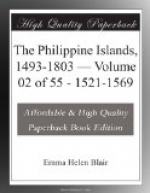[85] In another document, dated February 20, 1565 (published in Col. doc. ined. Ultramar, iii, pp. 81, 82), Legazpi personally verified the possession taken by Ybarra, Andres de Urdaneta being witness thereto. On that day Legaspi took possession not only of Cibabao but of the adjacent islands.
[86] In Col. doc. ined. Ultramar (p. 336), this name is given as “ypolito atanbor.”
[87] Many of these names are signed with a rubrica or flourish, which, like the French paraphe, was customary as a protection against forgery.
[88] Apparently referring to the president of the Audiencia of New Spain, although the formal address is to that body as a whole.
[89] This list does not accompany the letter, either in the Sevilla archives or in Doc. ined; but see Bibliographical Data for this document, at end of this volume.
[90] The Spanish quintal varied in different provinces and colonies as follows (equivalents given in U.S. pounds): Aragon, 109.738476; Castile (and Chile), 101.6097; Asturias, 152.281185; Catalonia, 87.281; Valencia (old measure), 109.728476; Buenos Aires, 101.4178. This unit of weight has been generally replaced by those of the metric system.
[91] Evidently this word is used in its early sense, of one who practiced blood-letting, etc., as the barber often performed duties now strictly pertaining to the physician.
[92] The arroba was equal to four quintals.
[93] The braza was a measure of length, equivalent to 16.718 decimeters, or 1.82636 yards (U.S.) The name originated (like the French brasse) in the primitive use of the human arm as a measure of length. The braza (square) was used in the Philippines as a measure of surface, being equivalent to 36 Spanish, or 30.9168 English, square feet.
[94] A short dagger with a broad blade.
[95] In the relation published in Col. doc. ined. Ultramar, ii, pp. 265-277, where these transactions are recounted in greater detail, these names are spelled Camutrian (Camutuan, Camotuan), and Maletec, respectively.
[96] Apparently the same as the Massaua of earlier documents.
[97] In the relation cited above, note 92, the name of this island is spelled (p. 277) Camiguinin.
[98] The second ship of the fleet, “San Pablo.” The “San Pedro” or flagship was spoken of as the capitana.
[99] A veil of thin gauze worn by the Moors. Evidently the term is used in this connection, as the Mohammedans of these islands were called Moros (Moors) by the Spaniards.
[100] Apparently referring to the island of Negros.
[101] The word is escaupiles, which was a species of ancient Mexican armor.
[102] An equestrian exercise with reed spears.
[103] The actual date of departure was the twenty-first.




